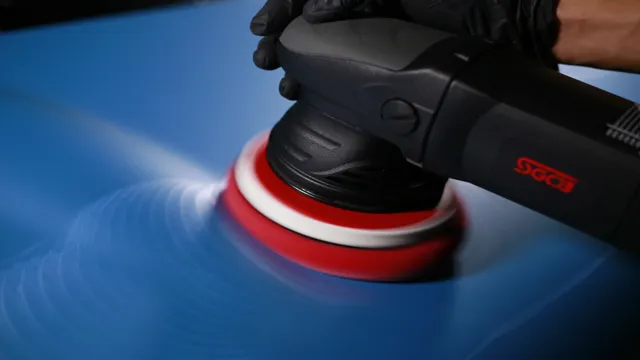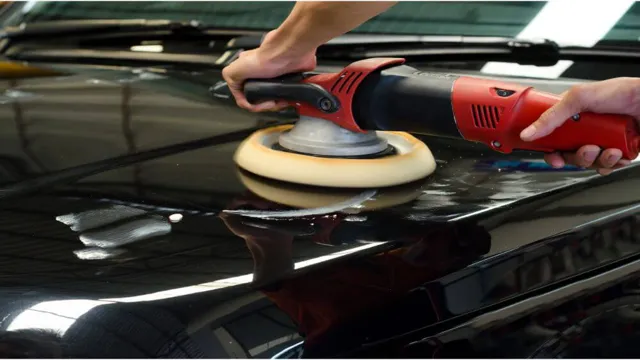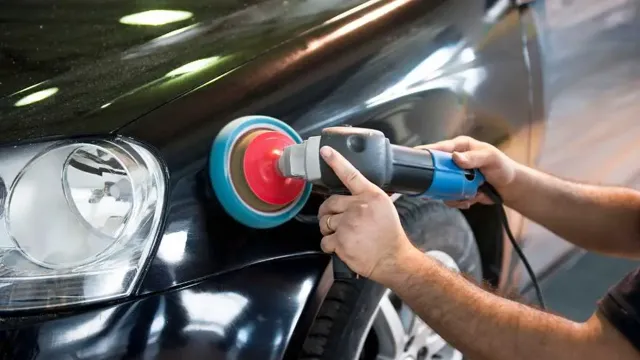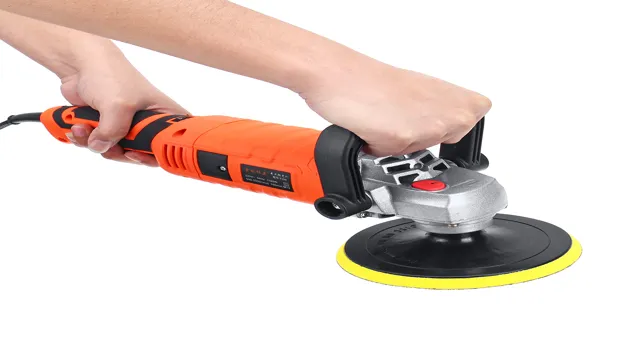
If you are a car enthusiast, you know how important it is to maintain a polished and well-waxed car. A coat of wax not only protects the paint from harsh elements but also adds a brilliant shine to the vehicle. Waxing a car, however, can be a daunting task if you are not familiar with the right tools and techniques.
This is where a polisher comes in handy! Using a polisher to wax your car helps to evenly distribute the wax, achieving a smooth and flawless finish. This blog post will guide you through the process of using a polisher to wax your car like a pro! So buckle up, and let’s dive into the world of waxing!
What is a Polisher?
Yes, you can use a polisher to wax a car. A polisher is a machine that is commonly used to remove minor scratches and swirls from the car’s paint surface. However, it can also be used to apply wax on the car’s surface.
The polisher, combined with a soft foam pad, can evenly spread the wax on the car’s surface, providing a uniform layer of protection. Using a polisher for waxing is much faster and more efficient than applying wax by hand. The polisher will also create a better bond between the wax and the car’s surface, resulting in a longer-lasting shine.
When looking for a polisher to use with wax, it is important to choose one with a slower speed setting, as this will prevent the wax from becoming too hot and melting onto the surface. However, it’s important to keep in mind that a polisher should only be used on a clean and smooth surface. If there are any dirt particles or debris on the surface, the polisher may end up scratching the car’s paint.
So, before applying wax with a polisher, make sure to thoroughly wash and dry the car’s surface.
Definition and Types
A polisher is a tool used to remove imperfections on a surface, usually made of plastic or metal. It is a type of power tool used for polishing, buffing, cleaning, and even sanding various types of surfaces. Polishers come in different types, such as rotary, dual action, or random orbital.
A rotary polisher is the most powerful type and is ideal for removing heavy scratches and swirl marks. Dual action and random orbital polishers, on the other hand, are designed for more delicate jobs such as removing minor scratches, applying wax, and polishing a car. Polishers are commonly used in automotive detailing, metal fabrication, woodworking, and various other industries where smooth and shiny surfaces are essential.
Whether you’re a professional detailer or a DIY enthusiast, a polisher can significantly improve the appearance of any surface by giving it a smooth and polished look.

How Does It Work?
A polisher is a tool used to buff, shine, and smooth surfaces of various materials, such as metal, stone, or wood. The device consists of an electric motor that drives a rotating pad which has different levels of abrasiveness. The polisher can be used for a wide range of applications, including automotive detailing, furniture restoration, and even jewelry-making.
The polisher works by applying friction to the surface being polished. As the pad rotates, it removes surface imperfections, small scratches, and oxidation, revealing a polished and glossy finish underneath. The level of abrasiveness of the pad varies depending on the type of surface being polished.
When using a polisher, it is recommended to start with the least abrasive pad and gradually work your way up until you reach the desired level of smoothness and shine. It’s essential to use the proper technique and apply adequate pressure to avoid damaging the surface being polished. A polishing compound can also be used to aid in the polishing process, providing additional lubrication and removing any excess material.
In conclusion, a polisher is a versatile and essential tool for anyone looking to restore and improve the appearance of various surfaces. With the right technique, it can help achieve a flawless, mirror-like finish that will enhance the look and durability of the surface. Whether you’re a professional detailer or a DIY enthusiast, a polisher is a valuable addition to your toolkit.
Benefits of Using a Polisher to Wax Your Car
Yes, you can use a polisher to wax your car. In fact, using a polisher to wax your car is an effective way to achieve a smooth and even finish. Not only does it save you time, doing it manually can be exhausting and can potentially cause scratches.
With a polisher, however, you can get the job done precisely and quickly. Moreover, it helps to evenly distribute the wax on the surface, making it more effective in protecting your car’s paint from UV rays and other environmental elements. Using a polisher also allows for better coverage of hard-to-reach areas, such as under door handles and around emblems, ensuring that your entire vehicle is protected by a layer of wax evenly.
So, if you’re looking to save time and energy while achieving a professional result, using a polisher to wax your car is worth considering.
Efficiency and Speed
Using a polisher to wax your car is an efficient and speedy way to achieve a flawless finish. Not only does it save time, but it also ensures that the wax is evenly distributed, making the car shine like new. When hand-waxing, you risk using too much wax in certain areas and not enough in others, creating an uneven finish.
With a polisher, you can control the amount of wax that’s applied to each section of the car, resulting in a consistent, high-quality shine. It’s like painting your nails with a brush as opposed to using a nail stamp; while both methods work, using a brush allows you to control the polish and get a more accurate and even application. Likewise, using a polisher to wax your car ensures that every inch gets the same amount of wax, no matter how difficult it may be to reach.
In the end, the benefits of using a polisher are clear: a faster, more efficient process that results in a perfect finish every time.
Better Results
Using a polisher to wax your car can provide a range of benefits that will leave your car looking better than ever before. One of the main benefits is that using a polisher can produce better results than waxing by hand alone. A machine polisher can evenly distribute the wax onto your car’s surface in a fraction of the time and with greater precision than what can be done by hand.
The result is a flawless, level shine that makes your car look like brand new. The polisher can also remove minor scratches and swirls, further enhancing the aesthetic of your car. Plus, the repetitive action of the polisher ensures that the wax is applied consistently throughout the entire surface area, resulting in a more durable, long-lasting coat.
By incorporating a polisher into your car waxing routine, you get a superior finish that lasts longer and provides better protection for your vehicle.
Ease of Use
When it comes to waxing your car, using a polisher can provide a multitude of benefits. One of the most significant advantages of using a polisher is the ease of use that it offers. Applying wax to your car by hand can be a time-consuming and laborious process, especially if you have a larger vehicle.
On the other hand, using a polisher can significantly reduce the amount of time and effort required to apply wax to your car. With a polisher, you can quickly and efficiently cover your car with wax, ensuring that every inch of your vehicle is adequately protected. Using a polisher can also ensure that the wax is applied evenly, providing a smooth and polished finish to your car.
Overall, using a polisher to wax your car can save you time and effort, while also ensuring a more professional and polished finish to your vehicle. So why not give it a try and give your car the ultimate shine it deserves?
Steps to Polish and Wax Your Car
Yes, you can use a polisher to wax your car, but there are some steps that you need to follow for best results. First, you need to clean your car thoroughly before applying wax. Then, you can use a foam pad or a microfiber pad to apply the wax evenly onto the car’s surface.
Next, use the polisher to spread the wax evenly, using a low speed setting to avoid damaging the paint’s clear coat. Once the wax has been spread evenly, use a clean microfiber towel to buff the wax until it shines. Remember to work in small sections, applying the wax in a circular motion and removing it in a back-and-forth motion to avoid streaks.
Using a polisher to wax your car can save time and effort, but it’s important to follow these steps carefully to avoid damaging your car’s paint.
Step 1: Pre-washing
If you’re looking to give your car an eye-catching shine, then polishing and waxing are essential to achieve that showroom finish. But before you start, it’s important to pre-wash your car to remove any dirt and grime that may scratch the surface during the polishing process. Begin by hosing down your car with water to remove any loose dirt.
Then, apply a specialized car shampoo solution to a sponge or microfiber cloth and gently scrub the entire surface of your car. Make sure to pay extra attention to the lower panels and edges where road grime may accumulate. Rinse the car thoroughly and dry it using a clean microfiber towel.
Now, your car is ready for the polishing and waxing process to give it that amazing, glossy finish that will make it stand out on the road. Remember, a proper pre-wash is essential to ensure a flawless and smooth polish and wax job.
Step 2: Polishing
After completing the first step of washing your car, it’s time to move on to the second step of polishing. This step will give your car a sleeker finish, making it look as good as new. Polishing will remove any minor scratches or imperfections on your car’s surface, giving it a smoother appearance.
You can choose to do this process by hand or with a polishing machine for faster results. Remember to use a high-quality polishing compound that’s appropriate for your car’s paint. Apply a small amount of the compound and work in circular motions, covering one section of the car at a time.
Be careful not to apply too much pressure as you could damage your car’s paint surface. Use a clean microfiber cloth to buff away the excess compound and reveal the shiny surface underneath. Don’t forget to polish the headlights as they can become cloudy over time.
Adding a protective layer of wax after polishing will give your car an added layer of shine while protecting it from the elements. Overall, this step is crucial to achieving your desired level of shine and making your car stand out on the road.
Step 3: Waxing
Now that the polishing is done, it’s time for the final step in achieving that shiny, showroom look for your car – waxing. Waxing provides an extra layer of protection for your paint, shielding it from the elements and preventing damage to the clear coat. Applying wax is a straightforward process that involves rubbing it onto the surface of the car in circular motions using a soft microfiber cloth.
Start by applying a small amount of wax onto the cloth and rub it onto the car in sections, letting it dry to a haze before buffing it off with another clean and dry cloth. Remember to work in shaded areas and apply the wax thinly and evenly to avoid streaks or smudges. Waxing your car helps prolong its beauty and appearance, making it worth the effort and time spent.
Conclusion
In conclusion, while it is technically possible to use a polisher to apply wax to your car, it’s a bit like using a hammer to open a bottle of wine. It might work, but it’s not the most efficient or effective method. Using the right tool for the job will save you time and effort, and result in a better finish.
So, put down the polisher and pick up some proper waxing tools – your car (and your sanity) will thank you for it!”
Final Thoughts and Recommendations
If you want to keep your car looking shiny and new, regular polishing and waxing is essential. Here are the steps you need to follow to get that showroom finish. First, wash your car thoroughly with a good quality car soap, and dry it completely.
Next, apply a rubbing compound to any scratches or swirl marks using a clean application pad. Follow this up with a coat of polishing compound, using a foam pad to bring back the shine. Once you’re happy with the finish, it’s time to wax your car.
Choose a high-quality car wax and apply it thinly and evenly using a foam applicator pad. Leave the wax to dry for around 10-15 minutes, or until it looks hazy. Finally, buff the wax off using a clean, soft microfiber cloth, working in circular motions.
Repeat these steps regularly – every few months is sufficient for most cars – and your car will always look its best. Remember, taking care of your car’s appearance not only makes it look good, but also protects the paintwork and helps to maintain its value. So don’t neglect this important task – your car will thank you for it!
FAQs
What is a polisher and what is its purpose?
A polisher is a machine used to buff and polish surfaces. Its purpose is to remove scratches, swirls, and other imperfections from the surface of a car, and to give it a glossy finish.
Can a polisher be used to wax a car?
Yes, a polisher can be used to distribute wax on a car’s surface, providing a uniform and even coverage. However, it is recommended to use a separate pad for waxing, as using the same pad for both buffing and waxing can cause cross-contamination.
What type of pads should I use with a polisher when waxing a car?
To apply wax with a polisher, you can use a foam or microfiber pad, depending on the type of wax you’re using. Foam pads are typically used for liquid waxes, while microfiber pads are used for paste waxes.
What is the difference between a rotary polisher and a dual-action polisher?
A rotary polisher uses a fixed, circular motion to polish the surface of a car, while a dual-action polisher oscillates in a circular motion, reducing the risk of damage or burning the car’s paint. Dual-action polishers are more beginner-friendly and versatile, while rotary polishers are better suited for professionals.
Can I use a polisher on a new car?
It is recommended to wait at least 90 days after purchasing a new car before using a polisher on its surface. This allows the paint to fully cure and prevents any potential damage to the car’s finish.
Do I need to wash my car before using a polisher?
Yes, it is important to thoroughly wash your car before using a polisher to remove any dirt or debris on the surface. This will prevent any scratches from appearing on the surface during the polishing process.
Can I use a polisher on a matte finish or vinyl-wrapped car?
No, it is not recommended to use a polisher on a matte or vinyl-wrapped car as it can cause damage to the finish. Instead, use a specialized detail spray or cleaner designed for these types of finishes.







